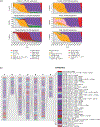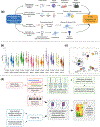Defining the risk of SARS-CoV-2 variants on immune protection
- PMID: 35361968
- PMCID: PMC9345323
- DOI: 10.1038/s41586-022-04690-5
Defining the risk of SARS-CoV-2 variants on immune protection
Abstract
The global emergence of many severe acute respiratory syndrome coronavirus 2 (SARS-CoV-2) variants jeopardizes the protective antiviral immunity induced after infection or vaccination. To address the public health threat caused by the increasing SARS-CoV-2 genomic diversity, the National Institute of Allergy and Infectious Diseases within the National Institutes of Health established the SARS-CoV-2 Assessment of Viral Evolution (SAVE) programme. This effort was designed to provide a real-time risk assessment of SARS-CoV-2 variants that could potentially affect the transmission, virulence, and resistance to infection- and vaccine-induced immunity. The SAVE programme is a critical data-generating component of the US Government SARS-CoV-2 Interagency Group to assess implications of SARS-CoV-2 variants on diagnostics, vaccines and therapeutics, and for communicating public health risk. Here we describe the coordinated approach used to identify and curate data about emerging variants, their impact on immunity and effects on vaccine protection using animal models. We report the development of reagents, methodologies, models and notable findings facilitated by this collaborative approach and identify future challenges. This programme is a template for the response to rapidly evolving pathogens with pandemic potential by monitoring viral evolution in the human population to identify variants that could reduce the effectiveness of countermeasures.
© 2022. Springer Nature Limited.
Conflict of interest statement
Conflicts of Interest:
DHB is a co-inventor on provisional vaccine patents (63/121,482; 63/133,969; 63/135,182), JDB consults for Moderna and Flagship Labs 77 on topics related to viral evolution, and is an inventor on Fred Hutch licensed patents related to viral deep mutational scanning, The Boon laboratory has received unrelated funding support in sponsored research agreements from AI Therapeutics, GreenLight Biosciences Inc., and Nano targeting & Therapy Biopharma Inc. The Boon laboratory has received funding support from AbbVie Inc., for the commercial development of SARS-CoV-2 mAb. A.C.M.B. was a recipient of a licensing agreement with Abbvie Inc., for commercial development of SARS-CoV-2 mAb, M.S.D. is a consultant for Inbios, Vir Biotechnology, Senda Biosciences, and Carnival Corporation, and on the Scientific Advisory Boards of Moderna and Immunome. The Diamond laboratory has received unrelated funding support in sponsored research agreements from Vir Biotechnology, Moderna, and Emergent BioSolutions, The Ellebedy laboratory received funding under sponsored research agreements that are unrelated to the data presented in the current study from Emergent BioSolutions and from AbbVie. A.H.E. has received consulting fees from InBios International, Inc, Fimbrion Therapeutics, Mubadala Investment Company and Goldman Sachs and is the founder of ImmuneBio Consulting, MBF has funding from Novavax which is outside the scope of this research. They had no role in the funded research from the SAVES consortium, the Garcia-Sastre laboratory has received research support from Pfizer, Senhwa Biosciences, Kenall Manufacturing, Avimex, Johnson & Johnson, Dynavax, 7Hills Pharma, Pharmamar, ImmunityBio, Accurius, Nanocomposix, Hexamer, N-fold LLC, Model Medicines and Merck, outside of the reported work. A.G.-S. has consulting agreements for the following companies involving cash and/or stock: Vivaldi Biosciences, Contrafect, 7Hills Pharma, Avimex, Vaxalto, Pagoda, Accurius, Esperovax, Farmak, Applied Biological Laboratories, Pharmamar and Pfizer, outside of the reported work. A.G.-S. is inventor on patents and patent applications on the use of antivirals and vaccines for the treatment and prevention of virus infections and cancer, owned by the Icahn School of Medicine at Mount Sinai, New York, outside of the reported work, Aubree Gordon serves on a scientific advisory board for Janssen, Erasmus MC has a Proprietary IP on MERS, BK is part of provisional patent applications for strategies for next generation SARS-CoV-2 vaccines that address diversity, The Icahn School of Medicine at Mount Sinai has filed patent applications relating to SARS-CoV-2 serological assays which lists Viviana Simon as a co-inventor and NDV-based SARS-CoV-2 vaccines which list Florian Krammer as co-inventor, Mount Sinai has spun out a company, Kantaro, to market serological tests for SARS-CoV-2. Florian Krammer has consulted for Merck and Pfizer (before 2020), and is currently consulting for Pfizer, Seqirus, 3rd Rock Ventures and Avimex. The Krammer laboratory is also collaborating with Pfizer on animal models of SARS-CoV-2, VDM have filed a patent on the reverse genetic system and reporter SARS-CoV-2, DCM receives funding from Moderna to perform blinded assessments of vaccine-elicited neutralizing antibody responses in clinical studies of their COVID-19 vaccines, A.S. is a consultant for Gritstone Bio, Flow Pharma, Arcturus Therapeutics, ImmunoScape, CellCarta, Avalia, Moderna, Fortress and Repertoire., PYS laboratory has received funding support in sponsored research agreements from GSK, Pfizer, Gilead, Novartis, Merck, IGM Biosciences, and Atea Pharmaceuticals. P.Y.S. is a member of the Scientific Advisory Boards of AbImmune and is Founder of FlaviTech, M.S.S serves on the advisory board for Moderna and Ocugen, PGT serves on the scientific advisory board for Immunoscape and Cytoagents and has consulted for Johnson and Johnson. PGT has received travel support and honoraria from Illumina and 10X Genomics. PGT has patents related to viral infection treatment and T cell receptor biology. S.P.J.W. and Z.L. have filed a patent with Washington University for VSV- SARS-CoV-2 mutants to characterize antibody panels. S.P.J.W has received unrelated funding support in sponsored research agreements with Vir Biotechnology, AbbVie, and sAB therapeutics. The findings and conclusions in this report are those of the authors and do not necessarily represent the official position of the US Centers for Disease Control and Prevention. Use of trade names is for identification only and does not imply endorsement by the US Centers for Disease Control and Prevention or the US Department of Health and Human Services.
Figures




References
-
-
Korber B et al. Tracking Changes in SARS-CoV-2 Spike: Evidence that D614G Increases Infectivity of the COVID-19 Virus. Cell 182, 812–827 e819, doi: 10.1016/j.cell.2020.06.043 (2020).
*This was the first study showing that a newly emerging mutation in the Spike protein could come to rapidly dominate across the globe, indicating a fitness advantage.
-
Publication types
MeSH terms
Substances
Supplementary concepts
Grants and funding
- U19 AI135995/AI/NIAID NIH HHS/United States
- R01 AI157155/AI/NIAID NIH HHS/United States
- HHMI/Howard Hughes Medical Institute/United States
- R01 AI153602/AI/NIAID NIH HHS/United States
- UM1 AI068618/AI/NIAID NIH HHS/United States
- P01 AI060699/AI/NIAID NIH HHS/United States
- R24 AI120942/AI/NIAID NIH HHS/United States
- S10 OD030463/OD/NIH HHS/United States
- 75N93021C00014/AI/NIAID NIH HHS/United States
- R01 AI154470/AI/NIAID NIH HHS/United States
- 75N91019D00024/CA/NCI NIH HHS/United States
- U01 AI150747/AI/NIAID NIH HHS/United States
- HHSN272201400008C/AI/NIAID NIH HHS/United States
- T32 AI007524/AI/NIAID NIH HHS/United States
- P51 OD011132/OD/NIH HHS/United States
- R01 AI134907/AI/NIAID NIH HHS/United States
- 75N93021C00017/AI/NIAID NIH HHS/United States
- R01 AI120997/AI/NIAID NIH HHS/United States
- U01 AI141990/AI/NIAID NIH HHS/United States
- U19 AI057266/AI/NIAID NIH HHS/United States
- U01 CA260476/CA/NCI NIH HHS/United States
- U01 AI151810/AI/NIAID NIH HHS/United States
- R37 AI080289/AI/NIAID NIH HHS/United States
- 75N93019C00076/AI/NIAID NIH HHS/United States
- HHSN272201400006C/AI/NIAID NIH HHS/United States
- R01 AI042790/AI/NIAID NIH HHS/United States
- 75N93021C00016/AI/NIAID NIH HHS/United States
- S10 OD026880/OD/NIH HHS/United States
- R01 AI146785/AI/NIAID NIH HHS/United States
- U01 AI144616/AI/NIAID NIH HHS/United States
- P01 AI158571/AI/NIAID NIH HHS/United States
- R01 AI129269/AI/NIAID NIH HHS/United States
- 75N93019C00050/AI/NIAID NIH HHS/United States
- HHSN272201800013C/AI/NIAID NIH HHS/United States
- 75N93019C00051/AI/NIAID NIH HHS/United States
- MR/V007025/1/MRC_/Medical Research Council/United Kingdom
- R01 AI136514/AI/NIAID NIH HHS/United States
- R01 AI141707/AI/NIAID NIH HHS/United States
- R01 AI148378/AI/NIAID NIH HHS/United States
- HHSN272201700060C/AI/NIAID NIH HHS/United States
- HHSN272201400007C/AI/NIAID NIH HHS/United States
- ZIA AI005156/ImNIH/Intramural NIH HHS/United States
- 75N93019D00025/AI/NIAID NIH HHS/United States
- R01 AI143639/AI/NIAID NIH HHS/United States
- 75N93019C00052/AI/NIAID NIH HHS/United States
LinkOut - more resources
Full Text Sources
Medical
Miscellaneous

